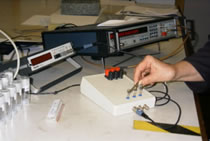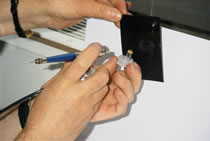It is the aim of this project to continue the use of artists' materials
in this way and to link it with piezoelectric quartz crystal (PQC) technology.
The useful property of piezoelectric quartz crystals is that they allow
a binding event e.g. coating to the gold substrate to be converted into
a measurable signal, for example resonance frequency changes. This offers
many applications and an increasing number of publications has illustrated
these phenomena.
The principle is based on the piezoelectric properties of materials such
as quartz crystals. Under an alternating electrical field mechanical vibrations
of the crystal were observed and ultrasonic waves were generated, the
quartz crystal vibrating near its resonant frequency. When it was included
in an appropriate electronic circuit, the measured oscillation frequency
was close to the resonant frequency (e.g 10MHz) and the generated wave
amplitude reached a maximum. Thus a modification of a physical characteristic
of the resonator, for example the global mass or the thickness led to
a resonator frequency variation. Typical shifts in the resonant frequency
of the crystal are of the order of 10kHz for coatings of micrometer thickness
and nanograms in mass.
Coated piezoelectric quartz crystals (typically AT cut) have been used
for the last 10 years also as air pollution detectors and testing of various
coatings has been performed for sensitivity to SO2, ozone, NO2, NH3 ,
H2S and other hazardous organic vapours. Potential CO2 sensing has also
been recently reported. Further shifts occur with alterations in the physicochemical
properties of the coating as a result of adsorption of molecules from
the environment. In a previous EU project poly(ethyleneimine) coated crystals
were used for localised RH measurement.
We will use the basic design (supplied by QuartzTech technology) to construct
a sensor array based on eight quartz crystals. The sensor chamber will
incorporate eight interchangeable piezoelectric quartz crystals. The instrument
will incorporate sample classification programmes that implement principal
component analysis (PCA) and discriminant function analysis (DFA) routines.
Classification is based on the nature of molecular interactions e.g. dispersion
forces, dipolar polar interactions, dipole interactions and hydrogen bonding.
Each sensor coating is chosen to optimise specific type of interaction.
In the case of our sensor array we would use quartz crystals coated with
artists' materials. We would start with varnish and proceed with tempera
based coatings.
We are interested in (1) assessing damage from the integrated response
of the synergistic action of environmental factors (2) possibility of
coatings specific to the action or more sensitive in their response to
certain pollutants. After the data processing and identification of locations
of high damage potential, suggestions for improvements, either to the
general environmental control or a particular microclimate surrounding
an artwork, would be given.


